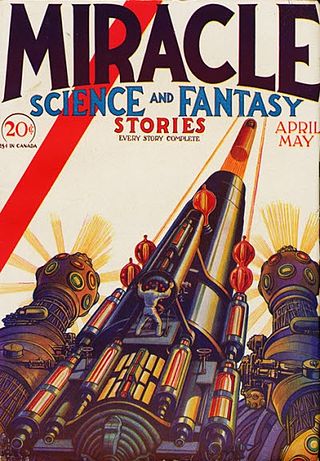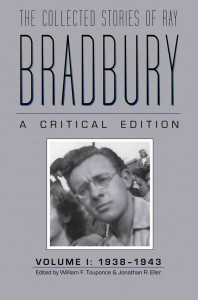
Forrest James Ackerman was an American magazine editor; science fiction writer and literary agent; a founder of science fiction fandom; a leading expert on science fiction, horror, and fantasy films; a prominent advocate of the Esperanto language; and one of the world's most avid collectors of genre books and film memorabilia. He was based in Los Angeles, California.

Wayne Francis Woodard, known by the pseudonym Hannes Bok, was an American artist and illustrator, as well as an amateur astrologer and writer of fantasy fiction and poetry. He painted nearly 150 covers for various science fiction, fantasy, and detective fiction magazines, as well as contributing hundreds of black and white interior illustrations. Bok's work graced the pages of calendars and early fanzines, as well as dust jackets from specialty book publishers like Arkham House, Llewellyn, Shasta Publishers, and Fantasy Press. His paintings achieved a luminous quality through the use of an arduous glazing process, which was learned from his mentor, Maxfield Parrish. Bok shared one of the inaugural 1953 Hugo Awards for science fiction achievement.

Ray Douglas Bradbury was an American author and screenwriter. One of the most celebrated 20th-century American writers, he worked in a variety of genres, including fantasy, science fiction, horror, mystery, and realistic fiction.

Science fantasy is a hybrid genre within speculative fiction that simultaneously draws upon or combines tropes and elements from both science fiction and fantasy. In a conventional science fiction story, the world is presented as grounded by the laws of nature and comprehensible by science, while a conventional fantasy story contains mostly supernatural elements that do not obey the scientific laws of the real world. The world of science fantasy, however, is laid out to be scientifically logical and often supplied with hard science-like explanations of any supernatural elements.
Skiffy is a deliberate humorous misspelling or mispronunciation of the controversial term "sci-fi", a neologism referring to science fiction.

R Is for Rocket (1962) is a short story collection by American writer Ray Bradbury, compiled for Young Adult library sections. It contains fifteen stories from earlier Bradbury collections, and two previously uncollected stories.

Famous Monsters of Filmland is an American genre-specific film magazine, started in 1958 by publisher James Warren and editor Forrest J Ackerman.

Emil Theodore Petaja was an American science fiction and fantasy writer whose career spanned seven decades. He was the author of 13 published novels, nearly 150 short stories, numerous poems, and a handful of books and articles on various subjects. Though he wrote science fiction, fantasy, horror stories, detective fiction, and poetry, Petaja considered his work part of an older tradition of "weird fiction." Petaja was also a small press publisher. In 1995, he was named the first ever Author Emeritus by the Science Fiction Writers of America (SFWA).
The 1st World Science Fiction Convention (Worldcon) was held on 2–4 July 1939 in the Caravan Hall in New York City, United States, in conjunction with the New York World's Fair, which was themed as "The World of Tomorrow". It was later retroactively named "NyCon I" by Forrest J Ackerman.
The Meadow is a radio drama by Ray Bradbury, written for a 1947 episode of the radio series World Security Workshop. It was included in the anthology Best One-Act Plays of 1947-1948. Bradbury later revised it into a short story (1953) and a stage play (1960).
"The Long Rain" is a science fiction short story by American writer Ray Bradbury. This story was originally published in 1950 under a different title in the magazine Planet Stories, and then in the collection The Illustrated Man. The story tells of four men who have crashed on Venus, where it is always raining.

Ross Rocklynne was the pen name used by Ross Louis Rocklin, an American science fiction author active in the Golden Age of Science Fiction. He also wrote under the pen names Paul Cahendon, R. L. Rocklin and R. Rocklinne.
The Mañana Literary Society was an informal meeting of science fiction writers in Los Angeles, California. Hosted by Robert A. Heinlein and his second wife Leslyn at their Laurel Canyon home, the membership included authors such as Anthony Boucher, Arthur K. Barnes, Edmond Hamilton, L. Ron Hubbard, Henry Kuttner, C.L. Moore, L. Sprague de Camp, Cleve Cartmill, Leigh Brackett, Roby Wentz, and Jack Williamson. The young Ray Bradbury, who had not yet made his first story sale, was a guest at one or two meetings. The weekly meetings took place in 1940 and 1941, until the Pearl Harbor attack resulting in the U.S. entering World War II.
"The Pedestrian" is a science fiction short story by American writer Ray Bradbury. This story was originally published in the August 7, 1951 issue of The Reporter by The Fortnightly Publishing Company. It is included in the collection The Golden Apples of the Sun (1953), but was dropped from later editions of this collection.

Echoes of Valor II is an American anthology of fantasy stories, edited by Karl Edward Wagner. It was first published in hardcover by Tor Books in August 1989. Tor subsequently issued a trade paperback edition in 1993.
Astonishing Stories was an American pulp science fiction magazine, published by Popular Publications between 1940 and 1943. It was founded under Popular's "Fictioneers" imprint, which paid lower rates than Popular's other magazines. The magazine's first editor was Frederik Pohl, who also edited a companion publication, Super Science Stories. After nine issues Pohl was replaced by Alden H. Norton, who subsequently rehired Pohl as an assistant. The budget for Astonishing was very low, which made it difficult to acquire good fiction, but through his membership in the Futurians, a group of young science fiction fans and aspiring writers, Pohl was able to find material to fill the early issues. The magazine was successful, and Pohl was able to increase his pay rates slightly within a year. He managed to obtain stories by writers who subsequently became very well known, such as Isaac Asimov and Robert Heinlein. After Pohl entered the army in early 1943, wartime paper shortages led Popular to cease publication of Astonishing. The final issue was dated April of that year.

The Collected Stories of Ray Bradbury is an ongoing scholarly, multi-volume series published by Kent State University Press, aiming to collect every short story written by American author Ray Bradbury in chronological order. The series is edited by William F. Touponce and Jonathan R. Eller, with extensive textual apparatus providing critical insights and annotations. The project is expected to span eight volumes and has received approval from the Modern Language Association (MLA) for its academic rigor. Each story is edited based on Bradbury's original manuscripts, with commentary on textual variants and publication history.
"Hollerbochen's Dilemma" is a science fiction short story by Ray Bradbury. Bradbury's first published work, it appeared in Forrest Ackerman's fanzine Imagination! in January 1938.
Myrtle Rebecca Smith Gray Nolan, known to science fiction history as Morojo or sometimes Myrtle R Douglas, was a science fiction fan, fanzine publisher, and cosplay pioneer from Los Angeles.
T. (Theodore) Bruce Yerke (1923–1998) was an American science fiction author and editor. A member of "an extensive network of active enthusiasts", he was an early and active member of the Los Angeles Science Fantasy Society, serving as its secretary for many years, and recruited Ray Bradbury as a member. With Forrest J Ackerman he edited the Hugo Award-winning fanzine Imagination!. His unfinished biography, Memoirs of a Superfluous Fan provides great insight into the early days of science fiction fandom in Los Angeles.















